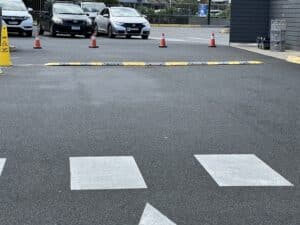

A small commercial carpark is a place where pedestrians, cars and facilities are in constant proximity – so what safety features do you need when building one or looking to make a safety upgrade?
Like it or not, carparking in commercial property investment matters. If customers arrive without the challenge of finding and navigating busy parking lots, it immediately puts them in the right frame of mind to enjoy their shopping experience. To attract people to your venue and to ensure that they ideally come back, access to your business needs to be both convenient and safe.
However, addressing commercial carpark safety often boils down to a wide variety of factors, such as your location, type of business, and the size of the carpark in question. While the budget will often influence the types of materials and safety features you use, the question is really a case of can you afford not to?
Along with being used by the general public, commercial carparks are often directly attached to a workplace, meaning that they’re often used by staff and employees as well. From private parking areas right through to large scale shopping complexes, all commercial carpark owners have a responsibility to ensure public safety.
While common hazards include slips, trips, falls and collisions with structures like safety barriers, vehicles or pedestrians, those with management or control of a commercial carpark should identify and control all hazards in the car park, including the entries and exits.
As an example, basic commercial carpark safety should address the following –
For business owners in the process of constructing a new commercial carpark or an upgrade, it’s important to do your research on the types of products on the market specifically designed for carpark safety. While the carpark in question may only require one or two physical barriers or additions to the ground as a means to boost awareness, some of the most common additions include the following.
Speed Humps – Generally used to slow traffic entering and exiting a commercial carpark, speed humps are also used throughout a carpark to ensure that drivers keep their speed down as a means to provide a safe environment for other vehicles, as well as pedestrians. Due to their bold colours, they’re often strategically positioned near building entries as well.
Rumble Bars – In the right set of circumstances, rumble bars are an incredibly cost effective way to reduce accidents and damage linked to drivers not paying attention to their surroundings. While rumble strips are commonly used on highways to alert drivers that they may be veering off the road, rumble bars are often found in drive thru outlets as curb spacers and lane dividers.
Wheel Stops – As the name would suggest, wheel stops are a traffic management device that works as a boundary when parking a vehicle. When correctly positioned, they alert drivers and stop them from running over the designated parking area and damaging buildings and property. A common addition to almost every commercial carpark, wheel stops help to avoid collisions and unnecessary damage to vehicles.
In Australia, road safety is an extremely serious business – and it should be. Although getting behind the wheel of a car is something that many of us do multiple times per day, the likelihood of an accident is sadly on the rise. If you are a commercial carpark owner looking to do your bit for road safety, it’s important to partner with the experts – but where do you find them?
At Speed Humps Australia, we’ve spent more than 15 years focusing on one thing: to provide one style of product, and to do it exceptionally well. We have worked tirelessly to develop specifications that do not fade or deteriorate, are easy to install, and are made from high-quality, recycled rubber for minimal environmental impact.
With just a handful of our clients around the nation including KFC, McDonalds, Taco Bell, Westfield, Shell and numerous Local Governments, our rumble bars, speed humps and wheel stops have been designed in house to truly go the distance.
As our design and production is all handled in house and supplied Australia wide, get in touch with us today to request a quote or discuss how we can help with providing a tailored solution to your unique project requirements.



For 10 years, our focus has been on one thing: to provide one style of product and to do it well.
Our wheel stops, speed humps and rumble bars meet Australian Standards, don’t fade, and we’ve never needed to replace one.

For 10 years, our focus has been on one thing: to provide one style of product and to do it well.
Our wheel stops, speed humps and rumble bars meet Australian Standards, don’t fade, and we’ve never needed to replace one.